
Basic introduction to soldering copper pipe.
- Subject:
- Agriculture
- Material Type:
- Activity/Lab
- Author:
- Lynn Hanson
- Date Added:
- 07/30/2020

Basic introduction to soldering copper pipe.

This teaching activity addresses environmental stresses on corals. Students assess coral bleaching using water temperature data from the NOAA National Data Buoy Center. Students learn about the habitat of corals, the stresses on coral populations, and the impact of increased sea surface temperatures on coral reefs. In a discussion section, the connection between coral bleaching and global warming is drawn.

In this video segment, ZOOM guest Cassie takes us on a tour of the coral reef near her home in Key Largo, Florida, and points out some of its unique features.

In this activity, student teams identify the locations of coral reefs around the world, examine infrared satellite images of the Earth, and research the impacts that are threatening the survival of coral reefs. Each team creates a short oral presentation describing the coral reef they have researched. Students then plot on a composite map the locations where coral bleaching is occurring. Student worksheets, a teacher guide, and assessment rubric are included. This activity is part of Coastal Areas: Coral Reefs in Hot Water, part of the lesson series, The Potential Consequences of Climate Variability and Change.
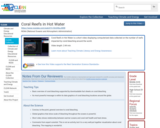
Coral Reefs in Hot Water is a short video displaying computerized data collected on the number of reefs impacted by coral bleaching around the world.
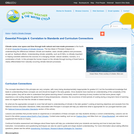
The concepts that underlie the fourth essential principle of climate literacy ("Climate varies over space and time through both natural and man-made processes.") are too complex for students in early and upper-level elementary school, but the foundational knowledge can be taught within existing curriculums and standards. This foundational knowledge will lead to understanding in later years. The author shows the correlation to the national science education standards, identifies misconceptions among elementary school students, suggests formative assessment probes, and identifies lessons and activities to make curriculum connections. The free, online magazine Beyond Weather and the Water Cycle is based on the seven essential principles of the climate sciences.

The students discover the basics of heat transfer in this activity by constructing a constant pressure calorimeter to determine the heat of solution of potassium chloride in water. They first predict the amount of heat consumed by the reaction using analytical techniques. Then they calculate the specific heat of water using tabulated data, and use this information to predict the temperature change. Next, the students will design and build a calorimeter and then determine its specific heat. After determining the predicted heat lost to the device, students will test the heat of solution. The heat given off by the reaction can be calculated from the change in temperature of the water using an equation of heat transfer. They will compare this with the value they predicted with their calculations, and then finish by discussing the error and its sources, and identifying how to improve their design to minimize these errors.

You are preparing your family’s emergency kits in case there is a need to leave your home quickly, or stay in your home without electricity or water. You need to be able to create an emergency supply kit that includes a lightweight water filtration device that is low cost. This will provide you with clean water regardless of your water source.
In this project, you will gain knowledge of natural disaster preparedness through the Red Cross Pillowcase project. You will research and experiment with the water cycle to learn how water is naturally filtered. You will then design and build a water filtration device that could filter water in an emergency situation.
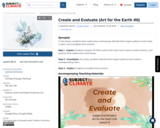
SYNOPSIS: In this lesson, students learn watercolour techniques, identify their target audience and create a rubric, and complete their artwork.
SCIENTIST NOTES: This lesson connects arts with science, and it is ideal to communicate environmental change. Students learn basic watercolor techniques and apply the technique to create an artwork that would make an impact in their community. The procedures and tools used in the lesson are suitable for achieving the lesson outcomes. The lesson has passed our science review process and is recommended for use.
POSITIVES:
-Students explore and utilize visual art techniques to evoke emotions and encourage change.
-Students identify a target audience and develop a rubric to evaluate the effectiveness of their project.
ADDITIONAL PREREQUISITES:
-This is lesson 6 of 6 in our 3rd-5th grade Art for the Earth unit.
-Watercolour paints, water, and paper are necessary for this lesson. Thick watercolour paper will allow for more control of the paint but is not necessary.
-Make sure to provide enough time for setup and cleanup.
-If students are completing reflections and rubrics, the Student Reflection & Rubrics Document must be printed beforehand or shared digitally with the students.
-The Inspire section is listed as 30 minutes long. The final parts of this project may take much longer, depending on what you intend to do with your students. Additional time will probably be needed for displaying artwork, completing reflections, completing rubrics, and distributing and collecting rubrics from the target audience.
DIFFERENTIATION:
-Displaying options, target audience, and evaluation methods can vary depending on time, resources, student ability, grade level, and school environment.
-Ideas for target audiences: another class or grade level, the general school community, families, or an outside community that the class decides could benefit from this education.
-Ideas for displaying options: in a classroom space, hallway, or common room space; in a digital exhibition; at a school event (e.g., art show, classwork presentation evening, parents' night, etc.)
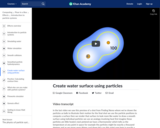
How do we draw a surface of water using only particles? In this video we'll introduce a powerful analogy using heat to help us out.
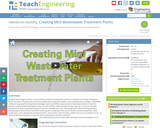
Student teams design and then create small-size models of working filter systems to simulate multi-stage wastewater treatment plants. Drawing from assorted provided materials (gravel, pebbles, sand, activated charcoal, algae, coffee filters, cloth) and staying within a (hypothetical) budget, teams create filter systems within 2-liter plastic bottles to clean the teacher-made simulated wastewater (soap, oil, sand, fertilizer, coffee grounds, beads). They aim to remove the water contaminants while reclaiming the waste material as valuable resources. They design and build the filtering systems, redesigning for improvement, and then measuring and comparing results (across teams): reclaimed quantities, water quality tests, costs, experiences and best practices. They conduct common water quality tests (such as turbidity, pH, etc., as determined by the teacher) to check the water quality before and after treatment.
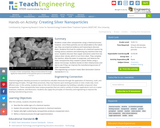
Students create silver nanoparticles using a chemical process; however, since these particles are not observable to the naked eye, they use empirical evidence and reasoning to discover them. Students first look for evidence of a chemical reaction by mixing various solutions and observing any reactions that may occur. Students discover that copper and tannic acids from tea reduce silver nitrate, which in turn form silver. They complete the reaction, allow the water to evaporate, and observe the silver nanoparticles they created in plastic dishes using a stereo microscope. Students iterate on their initial process and test to see if they can improve the manufacturing process of silver nanoparticles.
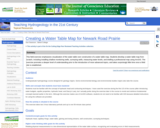
Because many students are familiar with contouring methods, they can mechanically construct water table maps from canned data sets with ease. However, their contouring abilities may mask their level of understanding. This field exercise aims to instill a deeper understanding of the nature of a water table surface as students also learn fundamental hydrogeological field techniques.
The exercise is based at Newark Road Prairie, which is owned and managed by Beloit College and located approximately five miles from campus. The property contains native prairie, wetlands, and a small stream. Although many schools may not own similar types of properties, land managers are often willing to allow the installation of shallow wells on public lands (e.g., county parks, state wildlife areas). Seven shallow monitoring wells and four staff gages are currently installed at Newark Road Prairie.
When we arrive at the field site, we begin by making observations on the subtle changes in topography and the direction of stream flow. Although we have just carried in all of the field equipment, I ask what type of information we will need to create a water table map. Handouts for the exercise are distributed after this discussion (see Supplementary Materials below).
Students are divided into groups of three for the field portion of the exercise, although each student ultimately drafts their own map using group and class data. Each group gets an electronic water level meter, a GPS unit, and a measuring tape, and we discuss the magnitude of error incorporated into the measurements taken by each of the instruments. We then review basic operation procedures for the water level meters and the GPS units, and students confirm that their GPS units are using the correct coordinate system and datum (UTM, NAD83).
We discuss surveying techniques as a class, and supplemental instructions are also provided in the handout (see Supplementary Materials below). We establish a centrally-located, bench mark (usually one of the staff gages) from which the students survey the wells and other staff gages. Each group is responsible for surveying at least two wells or staff gages. Groups distribute their surveying results to the rest of the class when we return to campus. Each group checks their results in the field, which reduces the chance of propagating surveying errors throughout the class.
Groups need to take water level measurements, survey wells, and record GPS coordinates for each well and staff gage. Additionally, because Newark Road Prairie has an established grid system with posts and markers at ten meter intervals, students measure the distance of each well/staff gage from at least three markers in order to evaluate the accuracy of their GPS measurements. Groups rotate the surveying equipment and are responsible for collecting all of the necessary data within the two lab periods. Two three-hour lab periods provide ample time for each group to collect the necessary data sets, including the time required to load/unload equipment and drive to/from the site. One 50-minute class period is provided for distributing survey results, compiling and printing base maps using ArcGIS, and contouring the water table maps.
(Note: this resource was added to OER Commons as part of a batch upload of over 2,200 records. If you notice an issue with the quality of the metadata, please let us know by using the 'report' button and we will flag it for consideration.)

Almost 1400 photographs, primarily studio portraits of people involved in the arts, including musicians; dancers; artists; literati; theatrical, film, and television actors and actresses. Includes black entertainers, particularly those associated with the Harlem Renaissance. Most are individual portraits, but also includes some group portraits. Sitters represented in ten or more photos are: Judith Anderson, Tallulah Bankhead, Anton Dolin, Ram Gopal, Hugh Laing, Alicia Markova, and Ethel Waters. A much smaller portion of the collection is an assortment of American landscapes.

If you are stuck to a rock it is tricky to get close enough to a partner to mate. One solution to this problem would be to release eggs or sperm into the open water, which is what many animals in this situation do. Acorn barnacles (Semibalanus balanoides), however, found a different solution. They have evolved the longest penis relative to their body size of any animal. In this video the penises of several barnacles are probing the neighborhood for mates. The penis is re-grown each mating season.

In this game, learn the five elements which make up the Earth's Critical Zone (soil, rock, water, organisms, and air).

Students dissolve selected salts and other compounds in water, let the water evaporate for about three weeks, and examine the crystals that grow. Students then draw crystal shapes and discuss the experiment. Discussion can include why and how crystals grow from solutions, why some minerals dissolve well and others do not, concepts of symmetry, and crystal systems and point groups.
(Note: this resource was added to OER Commons as part of a batch upload of over 2,200 records. If you notice an issue with the quality of the metadata, please let us know by using the 'report' button and we will flag it for consideration.)
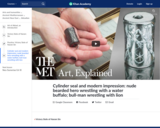
Met curator Yelena Rakic on reading into Cylinder seal and modern impression: nude bearded hero wrestling with a water buffalo; bull-man wrestling with lion from Mesopotamia, c. 2250–2150 B.C.E. . Created by The Metropolitan Museum of Art.
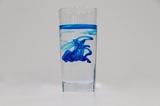
To investigate the movement of water into and out of a polymer. Gummy Bears are made of gelatin and sugar. Gelatin is a polymer that forms large three-dimensional matrices which give structural support to jellies and jams, and a lot of other things you use every day. This process will simulate what happens in your body cells.

D-Lab Development addresses issues of technological improvements at the micro level for developing countries—in particular, how the quality of life of low-income households can be improved by adaptation of low cost and sustainable technologies. Discussion of development issues as well as project implementation challenges are addressed through lectures, case studies, guest speakers and laboratory exercises. Students form project teams to partner with mostly local level organizations in developing countries, and formulate plans for an IAP site visit. (Previous field sites include Ghana, Brazil, Honduras and India.) Project team meetings focus on developing specific projects and include cultural, social, political, environmental and economic overviews of the countries and localities to be visited as well as an introduction to the local languages.